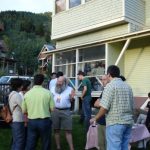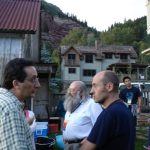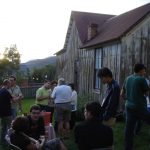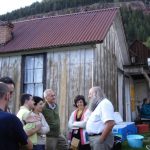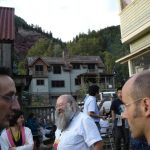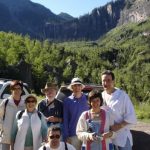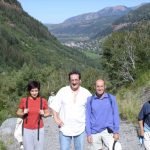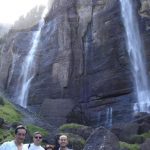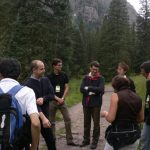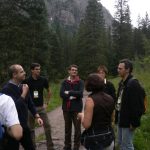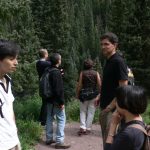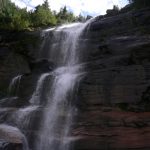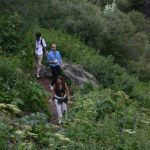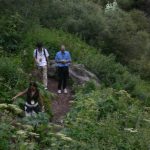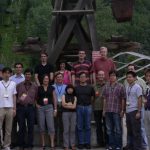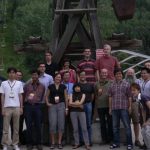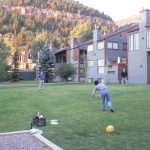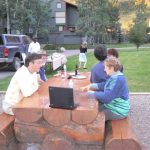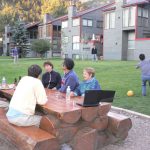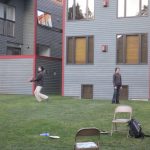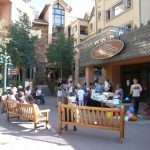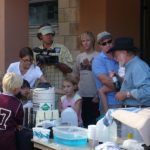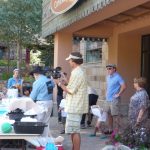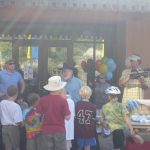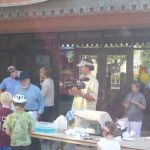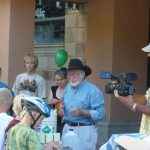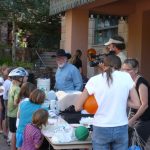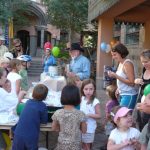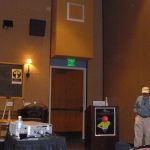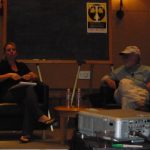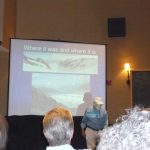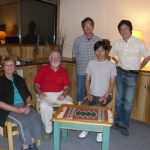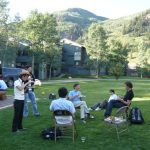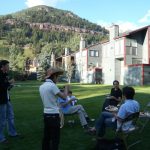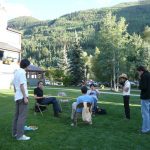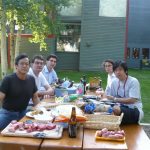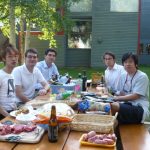Telluride Summer Workshop “The Complexity of Dynamics and Kinetics in Many Dimensions” organized by Tamiki Komatsuzaki, Mikito Toda and R. Stephen Berry
Telluride Workshop on
The Complexity of Dynamics and Kinetics in Many Dimensions
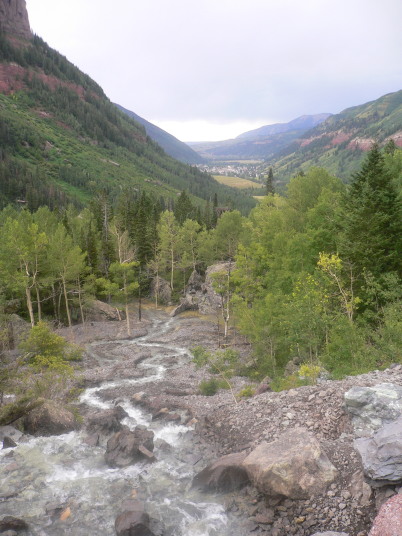
From Braidal Veil Trail in Telluride. They are winding, aperiodic
but yet somewhat ordered (for a certain temporal period) to the goal,
reminiscent of what functions are in complex systems.
August 13-24 2007
Camel’s Garden Resort Hotel
Telluride Summer Research Center
Telluride, CO, USA
This workshop is aimed at focusing on complexity of dynamics and kinetics in chemical reactions from small to large systems in terms of the underlying multidimensional state space structure. We also aim at having the first interdisciplinary meeting bringing researchers in different fields (from mathematics, chemistry, nonlinear and biological physics) together in a working environment.
State Space Geometry of Chemical Reaction Dynamics:
One of the key concepts just recently developed that we want to deepen more is the so-called normally hyperbolic invariant manifold (NHIM) which mediates chemical reactions in a deterministic fashion, even in a sea of chaos. The NHIM takes the place of the periodic orbit dividing surface (PODS) which is one of the most successful concepts developed several decades ago to enable us to resolve the complex behavior in reaction dynamics. The PODS is however limited solely to systems of two degrees of freedom. The NHIM has a great promise to generalize the PODS for systems of many degrees of freedom. However many problems still need to be resolved for NHIMs. For instance, How does the NHIM ruin or bifurcate in a high energy regime? Is the NHIM the appropriate general concept for autonomous, non-autonomous, or dissipative dynamical systems? How can one extract the NHIM in dissipative systems or what is the counterpart in the quantum systems? Moreover, is there any procedure to identify the existence of the NHIM and the stable and unstable manifolds implicitly or even explicitly from time series? (This could bridge the fundamental geometric theory of the state space and enable the concept to be used for large systems such as proteins.)
Clusters, Liquids and Proteins as Complex Systems:
The more the degrees of freedom, the more the nonlinear couplings mask the complexity of dynamics, which seem to support statistical approximation in full. Nature may not be so simple. So far, most observed kinetics of complex systems has been a consequence of averaging over an ensemble of many activated barrier crossings with multiple time scales. The recent remarkable experimental developments in single molecule spectroscopy hold great promise to reveal the complexity of complex systems, e.g., proteins. Several single molecule measurements have clarified the existence of long term molecular memory, such as anomalies in the diffusion process. Some coarse graining techniques have shed light on the existence of the buried regulatory structure in large complex systems like proteins and liquids. Here new disciplinary interactions are quite crucial to taking away “barriers” among the disciplines. For instance, Lagrangian coherent structure can reveal the dynamic role of water near proteins. A nonlinear time series analysis like computational mechanics may bridge between such large complex systems and the geometrical theory like NHIM, applicable so far only to small systems in practice. There exist many such subjects to be overcome. This Telluride workshop will be different from a traditional conference, but very much in the spirit established for Telluride. This workshop is aimed at exploring the new, exciting, open questions, by stirring people working in different disciplines and different subjects and fields to begin new collaborations. This is the objective, rather than solely to learn about all the wonderful things the participants have already done. Some of the most interesting Telluride workshops have been done in a format in which the first meeting is devoted to setting an agenda of the open topics to be discussed during the first week, choosing who should be the formal presenter of each of those topics, and setting the day for each presentation. The material that would, in a traditional conference, be presented in a talk, would have been contained in the pre-circulated papers. Then everyone will know the substance of where each subject stands and the focus can be on what needs to be investigated next, and how those things could be approached. The second week can be devoted to starting to pursue those investigations.
Participants
| THOMAS BARTSCH | Loughborough University, UK | |
| R. STEPHEN BERRY | University of Chicago, USA | |
| ANIRUDDHA CHAKRABORTY | University of Oregon, USA | |
| SERGY GREBENSHCHIKOV | Max Planck Institute, Goettingen, Germany | |
| JASON GREEN | University of Chicago, USA | |
| JOHANNES-GEERT HAGMANN | Lyon-laboratoire de Physique, France | |
| GEORGE HALLER | Massachusetts Institute of Technology, USA | |
| MANUEL INARREA | Universidad de La Rioja, Spain | |
| CHARLES JAFFE | West Virginia Universtiy, USA | |
| MICHAEL E. KELLMAN | University of Oregon, USA | |
| TAMIKI KOMATSUZAKI | Kobe University, Japan | |
| JESUS PALACIAN | Universidad Pública de Navarra, Spain | |
| ANA I. PASCUAL | Universidad de La Rioja, Spain | |
| VERED ROM-KEDAR | The Weizmann Institute of Science, Israel | |
| HIROSHI TERAMOTO | Kobe University, Japan | |
| MIKITO TODA | Nara Womens University , Japan | |
| VIVIAN TYNG | Universtiy of Oregon, USA | |
| TURGAY UZER | Georgia Inst. Tech., USA | |
| HOLGER WAALKENS | University of Bristol, UK | |
| CHENGJU WANG | University of Chicago, USA | |
| LAURENT WIESENFELD | University Joseph-Fourier, France | |
| TOMOHIRO YANAO | Kyoto University, JAPAN | |
| PATRICIA YANGUAS | Universidad Publica de Navarra, Spain |
Workshop dates and venue
The workshop will begin at 8:15 am on Monday, August 13 and end 12:00 pm on Friday, August 24. The workshop will be held at the Camel’s Garden Resort Hotel. Maps showing the location of the Camel’s Garden Resort Hotel, the town of Telluride, and the region are located here. You will have access to the internet, faxes, express mail services, and so forth.
Program (First Week) (pdf file)
August 13(Mon):
Setting an agenda of the topics to be discussed
R. Stephen Berry, University of Chicago, USA
Tamiki Komatsuzaki, Kobe University, Japan
August 14(Tus):
Morning Session:
Charles Jaffe,West Virginia Universtiy, USA
Jesus Palacian, Universidad Publica de Navarra, Spain
Mike Kellman, University of Oregon, USA
Afternoon Session:
George Haller, Massachusetts Institute of Technology, USA
Tomohiro Yanao, Kyoto University, JAPAN
August 15(Wed):
Morning Session:
Thomas Bartsch, Loughborough University, UK
Holger Waalkens, University of Bristol, UK
Hiroshi Teramoto, Kobe University, Japan
Afternoon Session:
Vered Rom-Kedar, The Weizmann Institute of Science, Israel
August 16(Thu):
Afternoon Session:
Vered Rom-Kedar, The Weizmann Institute of Science, Israel
Mikito Toda, Nara Womens University , Japan
Sergy Grebenshchikov, Max Planck Institute, Goettingen, Germany
August 17(Fri):
Morning Session:
Laurent Wiesenfeld, University Joseph-Fourier, France
Patricia Yanguas, Universidad Publica de Navarra, Spain
Vivian Tyng, Universtiy of Oregon, USA
Afternoon Session:
Sergy Grebenshchikov, Max Planck Institute, Goettingen, Germany
Open discussions
Program (Second Week)
August 20(Mon):
Setting an agenda of the topics to be discussed
Holger Waalkens, University of Bristol, UK
Johannes-Geert Hagmann, Lyon-laboratoire de Physique, France
August 21(Tus):
Tamiki Komatsuzaki, Kobe University, Japan
Laurent Wiesenfeld, University Joseph-Fourier, France
August 22(Wed):
R. Stephen Berry, University of Chicago, USA
Turgay Uzer, Georgia Inst. Tech., USA
Thomas Bartsch, Loughborough University, UK
August 23(Thu):
Mikito Toda, Nara Womens University , Japan
Tomohiro Yanao, Kyoto University, JAPAN
Hiroshi Teramoto, Kobe University, Japan
Open discussions
August 24 (Fri):
Free day & Open Discussions
Circulation (See Preprints/reprints)
We would greatly appreciate if you send us your recent articles by pdf files (or simply the list of articles and the web site address one can download them) you would like to pre-circulate in the workshop. This is the first interdisciplinary workshop composed of people having several different backgrounds (mathematics, chemistry, nonlinear and biological physics) working on complexity of dynamics and kinetics in many dimensions. Therefore, some brief notes (abstract including the motivation, introduction, and some unresolved problems,…) will also be highly welcome.
Registration
One can register the workshop via the following web page: http://www.telluridescience.org/registration.htm
(This registration fee is for running our conference at Telluride Science Research Center (TSRC), including using computational facilities and breakfast (a huge variety including hard boiled eggs, ham, bread, pastries, bagels, cheese, juice, coffee, tea) during the workshop) If you only stay one week, e.g., Aug 13-18 or 20-25, PLEASE NOTE IT IN THE COMMENT FIELD of the registration form in that page.
Ms. Nana Naisbitt, Executive Director of Telluride Science Research Center said “when we go to charge those participants we will adjust the fee to $250. This must be done by hand. FYI, no one is “automatically” charged. We cannot make the system adjust the registration fee. So it will appear as $500 until we adjust it manually at the time of charging.” You can get your receipt and lodging confirmation at www.telluridescience.org and click on the grey button on the left hand side of the home page marked “Receipts and Confirmations”, then enter the same email you entered when you registered, find our workshop name, and then click on “view your receipt.” Your receipt will be marked “Paid” if your lodging has been confirmed and if TSRC has received payment via credit card or check. Please contact Nana if you have any questions for the registeration and housing at nana@telluridescience.org or 1-970-708-0004.
Some Social Events
August 13:
Opening Reception with wine and beer, soft drinks, and appetizers (15US$ for each if you would like to attend).
August 14: 18:00-19:15
Pinhead Town Talk at the Conference Center in mountain Village
August 16: 18:00-
Picnic provided by TSRC (Your accompanying persons are also quite welcome to join)
August 21: 18:00-19:15
Pinhead Town Talk at the Conference Center in mountain Village
Speaker: James Franck Distinguished Service Professor Emeritus R. Stephen Berry, Department of Chemistry, University of Chicago, USA
August 23: 18:00-
Picnic provided by TSRC (Your accompanying persons are also quite welcome to join)
Telluride Tips Frequently Asked Questions
please visit here and the travel tips page provided by Douglas J. Tobias .
Organizers
Tamiki Komatsuzaki
Nonlinear Science Laboratory,
Department of Earth and Planetary Sciences,
Kobe University, Japan
TEL: +81-78-803-5739 FAX: +81-78-803-5757
E-mail: tamiki@kobe-u.ac.jp
http://www2.kobe-u.ac.jp/~tamiki
Mikito Toda
Physics Department, Nara Women’s University, Japan
TEL & FAX : +81-742-20-3383
E-mail : toda@ki-rin.phys.nara-wu.ac.jp
http://minnie.disney.phys.nara-wu.ac.jp/~toda/index.html
R. Stephen Berry
Department of Chemistry, and the James-Franck Institute,
University of Chicago, USA
TEL +1-773-702-7021 FAX:+1-773-702-0805
E-mail: berry@uchicago.edu
http://chemistry.uchicago.edu/fac/berry.shtml

